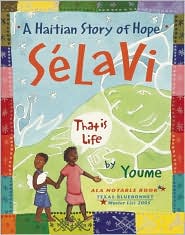Title: Selavi, That is Life: A Haitian Story of Hope Author: Youme Landowne Copyright: 2004 Grades: K-5 (all grades should read this book!)  |
Book Club Blog
By: Kimberley Vicari
Summary: The story I chose to read was Selavi: A Haitin Story of Hope, That is Life by Youme Landown. This true story told the tale of Selavi’s struggles. Selavi is a small boy who finds himself homeless on the streets of Haiti. He finds other street children who he becomes close with. The children share their food, a place to sleep and their homeless, unfortunate situations. Althought faced with tragic situations, Sélavi and the other children never blamed themselves or others for it. After being threatened by police on the streets, the children take refuge in a church. With help from church members, they create their own orphanage! Together they declare a message of hope through murals and radio programs.
Element 4 Social Change:
Sélavi and the others create their own orphanage and through the use of media to inform others of the situation. They took their bad situations and try to make a change, not only for themselves but for others in their situation. Selavi and the children are making the world a better place and doing it with an optimistic attitude. This book uses element four and is
Activity:
In an activity, I want to incorporate learning about the violation of children’s rights through the use of this literature. Students will see and reflect on examples of human kindness and collective action for the common good in this book. Students will be asked to do a journal entry on the concept of social action and human rights. First, I will share a quote from the book and then pose a question for the students. I will share the following quote from some homeless children in Haiti who worked together to build the shelter and an activist radio program to help each other. They were asked what they would like to say to young people in the United States. They said, “Tell them we are here, that we are no less than wealthy children, and that there should be a place for everyone at the table.” Ask students to reflect on and share their thoughts and interpretation of the quote. Then I will pose the question, “Do we have a responsibility to be concerned with the well-being of others and not just ourselves?” No answer is wrong. I want the students to really think about this and understand what is right and what is wrong and how they can make a difference!!!
No comments:
Post a Comment